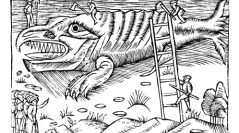

 Anthropozoologica
53 (11) - Pages 125-137
Anthropozoologica
53 (11) - Pages 125-137Conrad Gessner’s (1516-1565) discussion of cetaceans and sea-monsters as part of the same distinct group of animals (HA 1558) highlights how in the work of mid-sixteenth century naturalists the taxonomical interacts with cultural, literary, and scholarly tradition. In addition to listing physical characteristics shared by all members of the group, Gessner refers to literary sources which blur the line between whales and monsters, to linguistic causes of such confusion, and to descriptions of cetaceans by various classical, mediaeval, and early modern authors. Alongside anecdotes about real but little-known cetaceans, he presents a range of monster-sightings and draws a connection between classical sirens, aquatic fairies and mermaids. Gessner’s encyclopaedic approach means his discussion is embedded in the scholarly dialogue of the mid-sixteenth century and provides insight in the thoughts of several of his contemporaries on cetaceans, the position of monsters in a taxonomy, and the existence of sea-monsters.
Cetaceans, sea-monsters, monstrous whales, literary tradition, taxonomy, sirens, mermaids, aquatic counterparts of terrestrial creatures, aspidochelone, teratology.